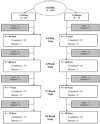Observational study of the development of diabetic macular edema following panretinal (scatter) photocoagulation given in 1 or 4 sittings
- PMID: 19204228
- PMCID: PMC2754061
- DOI: 10.1001/archophthalmol.2008.565
Observational study of the development of diabetic macular edema following panretinal (scatter) photocoagulation given in 1 or 4 sittings
Abstract
Objective: To compare the effects of single-sitting vs 4-sitting panretinal photocoagulation (PRP) on macular edema in subjects with severe nonproliferative or early proliferative diabetic retinopathy with relatively good visual acuity and no or mild center-involved macular edema.
Methods: Subjects were treated with 1 sitting or 4 sittings of PRP in a nonrandomized, prospective, multicentered clinical trial. Main Outcome Measure Central subfield thickness on optical coherence tomography (OCT).
Results: Central subfield thickness was slightly greater in the 1-sitting group (n = 84) than in the 4-sitting group (n = 71) at the 3-day (P = .01) and 4-week visits (P = .003). At the 34-week primary outcome visit, the slight differences had reversed, with the thickness being slightly greater in the 4-sitting group than in the 1-sitting group (P = .06). Visual acuity differences paralleled OCT differences.
Conclusions: Our results suggest that clinically meaningful differences are unlikely in OCT thickness or visual acuity following application of PRP in 1 sitting compared with 4 sittings in subjects in this cohort. More definitive results would require a large randomized trial. Application to Clinical Practice These results suggest PRP costs to some patients in terms of travel and lost productivity as well as to eye care providers could be reduced.
Trial registration: clinicaltrials.gov Identifier: NCT00687154.
Conflict of interest statement
Conflicts of interest statement: None
Comment in
-
Diabetic macular edema following panretinal photocoagulation.Arch Ophthalmol. 2010 Feb;128(2):262; author reply 262. doi: 10.1001/archophthalmol.2009.392. Arch Ophthalmol. 2010. PMID: 20142560 No abstract available.
References
-
- The Diabetic Retinopathy Study Research Group. Preliminary report on effects of photocoagulation therapy. Am J Ophthalmol. 1976;81:383–396. - PubMed
-
- Chew EY, Ferris FL, 3rd, Csaky KG, et al. The long-term effects of laser photocoagulation treatment in patients with diabetic retinopathy: the early treatment diabetic retinopathy follow-up study. Ophthalmology. 2003;110:1683–1689. - PubMed
-
- Early Treatment Diabetic Retinopathy Study Research Group. Early photocoagulation for diabetic retinopathy ETDRS report number 9. Ophthalmology. 1991;98:766–785. - PubMed
-
- McDonald HR, Schatz H. Visual loss following panretinal photocoagulation for proliferative diabetic retinopathy. Ophthalmology. 1985;92:388–393. - PubMed
-
- Dharma S, Bazan HE, Peyman GA, Atef MS. Production of platelet-activating factor in photocoagulated retinas. Curr Eye Res. 1991;10:1031–1035. - PubMed
Publication types
MeSH terms
Associated data
Grants and funding
LinkOut - more resources
Full Text Sources
Medical
Research Materials


